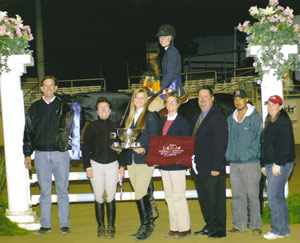August 21, 2010: The $35,000 Summer Classic II Grand Prix, presented by Equ Lifestyle Magazine
The weather on Saturday afternoon was close to ideal, with a breeze and temperatures in the 70s. Spectators gathered in the Medal Club, on the hillside and in the hilltop VIP tent to watch the last of the summer grand prix events at the Rancho Mission Viejo Riding Park.
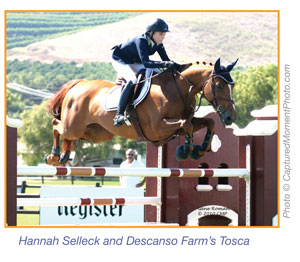 Thirty-three horse and rider duos stepped up (or in some cases down) to the challenge of the Leopoldo Palacios designed course in the $35,000 Summer Classic II Grand Prix, presented by Equ Lifestyle Magazine. Of all those who had aspirations of going clean, only the first two on course, Lane Clarke aboard Bay Rose’s Nikko and Hannah Selleck riding the fiery mare Tosca of Descanso Farm, were able to do so. Both young and ambitious, it was twenty-one-year-old Selleck who came out on top with a stellar double clear ride for the win.
Thirty-three horse and rider duos stepped up (or in some cases down) to the challenge of the Leopoldo Palacios designed course in the $35,000 Summer Classic II Grand Prix, presented by Equ Lifestyle Magazine. Of all those who had aspirations of going clean, only the first two on course, Lane Clarke aboard Bay Rose’s Nikko and Hannah Selleck riding the fiery mare Tosca of Descanso Farm, were able to do so. Both young and ambitious, it was twenty-one-year-old Selleck who came out on top with a stellar double clear ride for the win.
Master course designer Palacios presented competitors with a technical track that demanded a careful, yet gutsy ride. There were a total of 17 obstacles which included a tricky bending line, a combination with a sizeable triple bar, another combination, a very tidy rollback turn to a skinny in five or six strides to the open water in a very tight ride to a vertical-vertical combination, and ended with a right-hand turn to a big oxer at the top of the field. All in a keep-up-the-pace time allowed of 87 seconds. “This was a very tough national grand prix. I tried to challenge the group as much as possible,” Palacios said.
The first two horse and rider teams made fault-free rides a reality. First to gallop onto the grass, Clarke jumped Bay Rose’s Nikko around the course just under the time allowed in 86.72 seconds. Next in the ring, Selleck brilliantly answered Clarke’s call and forced the jump-off, laying down a clean and aggressive first round ride in 79.98 aboard her chestnut mount Tosca.
“The track suited Tosca,” said Selleck of her 14-year-old Belgium mare. “The opening and shortening between fences is exactly what she likes.”
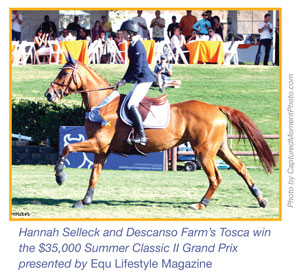 As the rest of the competitors took to the course, Palacios’ challenge was evident. All remaining exhibitors picked up faults of some kind – rails fell, time allowed was exceeded, hooves landed in the water, and refusals, run-outs and accidental dismounts also occurred.
As the rest of the competitors took to the course, Palacios’ challenge was evident. All remaining exhibitors picked up faults of some kind – rails fell, time allowed was exceeded, hooves landed in the water, and refusals, run-outs and accidental dismounts also occurred.
“Leopoldo’s courses are hard, technical and have a tight time allowed,” explained second place rider, Clarke. “He does a great job of getting rails in different places, plus the horses and the riders always learn something.”
As the first to take in the jump-off, Clarke knew his ride had to be strong. “Hannah is a rocket and I knew I had to put the pressure on her,” Clarke explained. Clarke and Bay Rose’s Nikko navigated the shortened track in a time of 48.98 seconds and picked up eight faults towards the end. “I am really happy with my horse,” Clark said. “He is green at the grand prix level and is coming along fantastically.”
Having the advantage of following Clarke in the jump-off, Selleck and Tosca galloped onto the International Field with an air of determination. “In the jump-off, the pressure was on. I just had to go out there and stick to my plan,” Selleck noted.
Selleck presented the crowd with a masterful ride and triumphantly crossed the timers without fault in 45.15 seconds to surpass Clarke and clinch her first win in the grand prix arena.
Although close but not clean in round one, some of the remaining prizewinners deserve mention. The fastest four-fault ride was Mexico City’s Jaime Azcarraga aboard his grey partner Celsius, who had just one unlucky rail for third place honors. Slightly over half a second behind Azcarraga, Susan Hutchison and El Dorado 29’s Cantano had four faults and picked up the fourth place prize. Fifth through seventh went to four fault rides from Mexican riders Eduardo Menezes and his horse Utopia, last week’s winner Otavio Penedo aboard Carando Equisearch and Eduardo Menezes riding Avargo Mercedes Benz.
Earning the eighth spot, Michelle Parker and Socrates De Midos (Cross Creek Farms Inc., owner) thrilled the crowd when they miraculously cleared fence six from a near standstill. It looked as though the duo was going to go clean until, like so many others before them, they lowered the height of the first element in the one stride at 13A for four faults. In addition to finishing second in the competition, Clarke also finished in the money aboard his second mount, Mickey Hayden’s McLord’s First John, stopping the clock just over the time allowed for one time fault in addition to eight jumping faults. Winner Selleck rode Descanso Farm’s Bauer to an eleventh place finish as the fastest of the twelve fault rides.
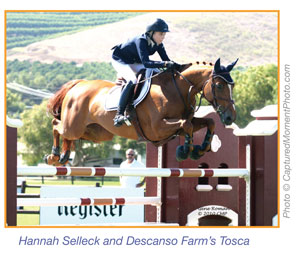 Thirty-three horse and rider duos stepped up (or in some cases down) to the challenge of the Leopoldo Palacios designed course in the $35,000 Summer Classic II Grand Prix, presented by Equ Lifestyle Magazine. Of all those who had aspirations of going clean, only the first two on course, Lane Clarke aboard Bay Rose’s Nikko and Hannah Selleck riding the fiery mare Tosca of Descanso Farm, were able to do so. Both young and ambitious, it was twenty-one-year-old Selleck who came out on top with a stellar double clear ride for the win.
Thirty-three horse and rider duos stepped up (or in some cases down) to the challenge of the Leopoldo Palacios designed course in the $35,000 Summer Classic II Grand Prix, presented by Equ Lifestyle Magazine. Of all those who had aspirations of going clean, only the first two on course, Lane Clarke aboard Bay Rose’s Nikko and Hannah Selleck riding the fiery mare Tosca of Descanso Farm, were able to do so. Both young and ambitious, it was twenty-one-year-old Selleck who came out on top with a stellar double clear ride for the win.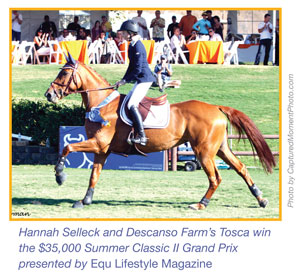 As the rest of the competitors took to the course, Palacios’ challenge was evident. All remaining exhibitors picked up faults of some kind – rails fell, time allowed was exceeded, hooves landed in the water, and refusals, run-outs and accidental dismounts also occurred.
As the rest of the competitors took to the course, Palacios’ challenge was evident. All remaining exhibitors picked up faults of some kind – rails fell, time allowed was exceeded, hooves landed in the water, and refusals, run-outs and accidental dismounts also occurred.